Have you ever dreamed of a living room that exudes calm, simplicity, and effortless style all at once? Japandi design, a perfect blend of Japanese minimalism and Scandinavian coziness, has become wildly popular for its ability to create serene yet sophisticated spaces. Its clean lines, neutral palettes, and natural materials make it a timeless choice for those seeking a peaceful retreat amidst the chaos of everyday life.
In this article, you’ll discover a treasure trove of inspiring ideas to transform your living room into a Japandi sanctuary. From choosing the right color schemes and furniture to incorporating traditional Japanese elements and subtle lighting, each tip is designed to help you craft a harmonious, stylish space. Whether you’re starting from scratch or looking to refine your current decor, these practical and beautiful ideas will guide you toward achieving that perfect balance of serenity and modern elegance.
1. Embrace Neutral Color Palettes for Calm and Cohesion

Creating a serene living room starts with the right color palette, and in Japandi style, neutrals reign supreme. These soft beiges, warm greys, and muted earth tones foster a peaceful, cohesive environment that feels both inviting and uncluttered.
The goal is to craft a space that exudes calmness, helping you unwind and disconnect from everyday chaos. Imagine a room where the walls are painted in a gentle, warm beige, complemented by a plush, light grey sofa and a soft taupe area rug.
Subtle variations in tone add depth without disrupting the tranquility, while natural light filters softly through sheer curtains, enhancing the subtle color shifts. Accents like a stone-colored throw pillow or a charcoal ceramic vase provide visual interest without overwhelming the senses.
The overall effect is a harmonious space that feels grounded and balanced, encouraging relaxation and mindfulness. To recreate this look, start by choosing a neutral base for your walls—think warm ivory or light taupe—and select furniture in similar muted tones.
Incorporate textiles such as linen cushions or wool throws in shades of cream, grey, or soft brown. Keep decorative accessories minimal, sticking to the same subdued color palette to maintain cohesion. This approach requires minimal effort but delivers maximum calming impact, making your living room a true sanctuary.
2. Incorporate Low-Profile, Minimalist Furniture
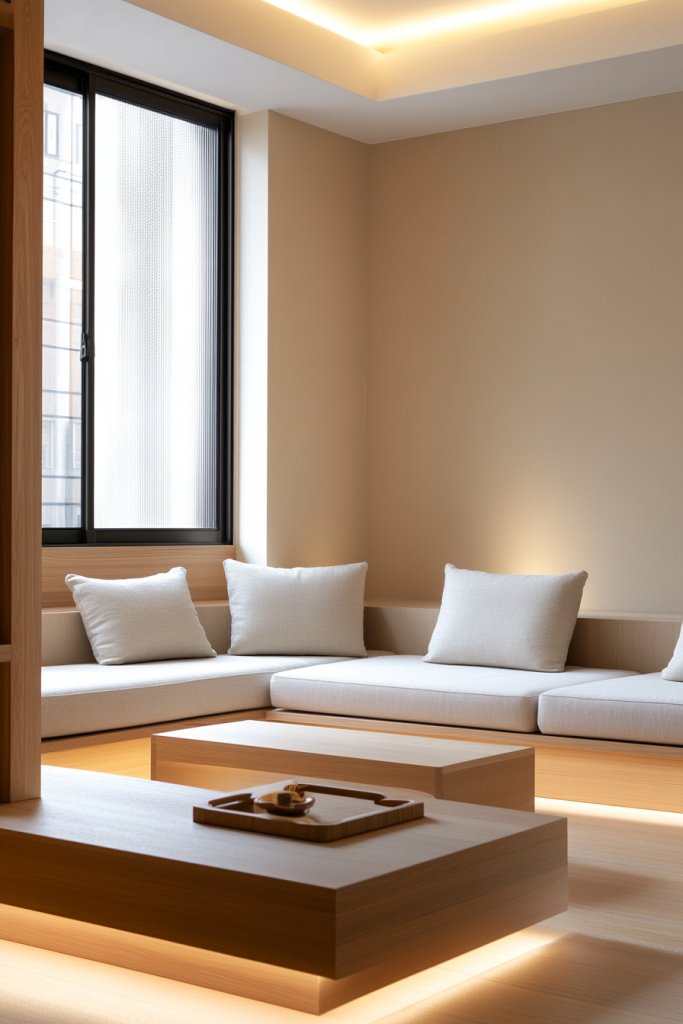
In Japandi living rooms, furniture is all about understated elegance and functionality, with low-profile pieces that emphasize openness and flow. These sleek, minimalist designs help create a balanced space that feels uncluttered and soothing, encouraging a sense of calm and effortless style.
Picture a low, wide sofa upholstered in a neutral fabric, with clean, straight lines that sit just above the ground. Complement it with a simple, rectangular coffee table made from light or dark wood with smooth edges, avoiding ornate details.
A platform-style media unit or side tables with minimalist silhouettes further reinforce the streamlined aesthetic. These pieces work together to keep sightlines clear, making the room appear larger and more inviting.
The overall vibe is one of quiet sophistication that invites you to relax without distraction. To implement this, choose furniture with simple geometric shapes—look for sofas with low armrests and thin legs, or tables with unembellished surfaces.
Opt for natural materials like oak, maple, or walnut, which add warmth and texture. For beginners, consider modular sofas or ready-made low tables from Scandinavian or modern furniture stores.
Keep accessories minimal, and focus on open space to highlight the furniture’s clean lines. This approach results in a harmonious, clutter-free environment that’s both stylish and functional.
3. Use Natural Wood Finishes for Warmth and Texture
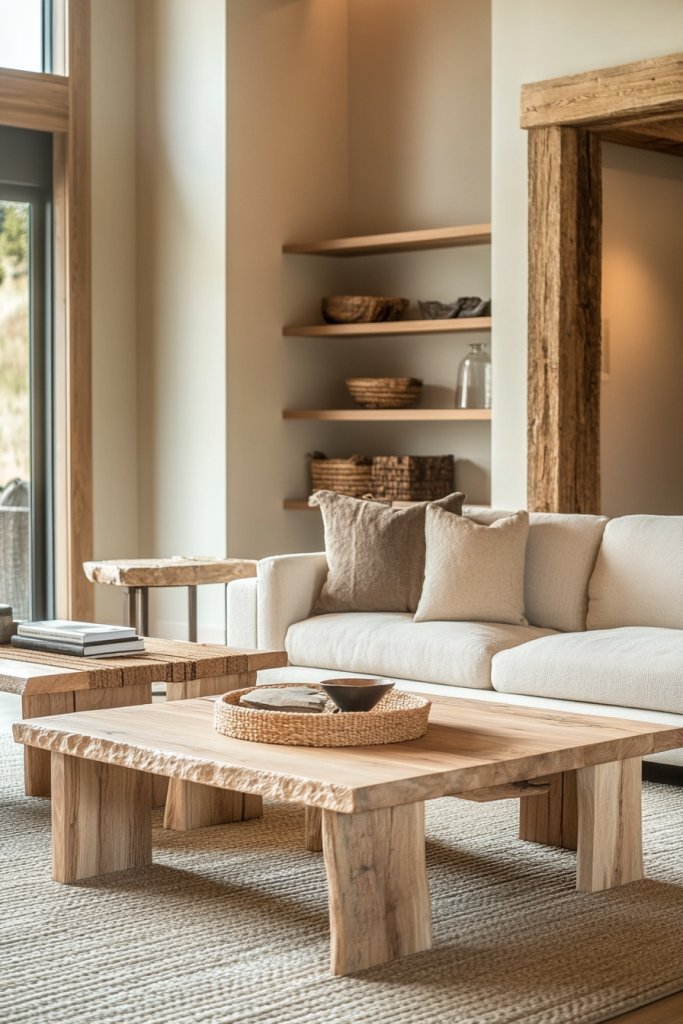
Natural wood accents are a hallmark of Japandi interiors, adding warmth and a tactile dimension that balances the room’s minimalist aesthetic. Whether light or dark, wood finishes bring organic appeal, making the space feel cozy yet sophisticated.
Visualize a living room with a light oak coffee table, a dark walnut sideboard, and a few wooden decorative objects like bowls or sculptures. The grain and texture of the wood are visible, inviting touch and adding visual interest.
Soft, woven textiles and neutral-colored ceramics complement the wood’s natural hues, creating a layered yet uncluttered look. The subtle scent of wood and the tactile experience of smooth surfaces enhance the sensory harmony of the space, making it feel both grounded and inviting.
To achieve this look, incorporate furniture and decor made from real wood—think light oak, ash, or dark walnut—and leave the finish natural or lightly stained to preserve the grain. For a budget-friendly option, look for secondhand or flat-pack furniture that features natural wood veneers.
Pair the wood elements with neutral textiles and ceramics to balance the textures. Regular dusting and gentle cleaning will keep the finishes looking fresh and beautiful. Embracing natural wood elevates your living room’s warmth and authenticity effortlessly.
4. Opt for Simple, Functional Coffee Tables

A key element in Japandi design is the coffee table’s simplicity and practicality. Instead of ornate or overly decorative pieces, choose tables that boast clean lines and unobtrusive forms, blending seamlessly into the overall aesthetic.
Imagine a rectangular coffee table crafted from smooth, light-colored wood with a minimalist frame and a flat surface—no unnecessary embellishments. Its understated design allows it to function as a focal point without overpowering the space.
The surface is perfect for a few well-chosen accessories like a ceramic tray or a small stack of books, maintaining the room’s uncluttered vibe. The simplicity of the piece invites ease of use and complements other furniture pieces, fostering a harmonious atmosphere.
To implement, look for coffee tables with sleek, unadorned surfaces made of birch, maple, or bamboo. Materials like laminate or composite can work as budget-friendly alternatives with similar aesthetic qualities.
Keep the size proportional to your seating area—generally, a table that’s about two-thirds the length of your sofa works well. Use minimal accessories to maintain the clean look, and consider multi-functional pieces with hidden storage if needed. This straightforward approach enhances both form and function, anchoring your living room beautifully.
5. Introduce Subtle Lighting with Paper or Fabric Fixtures
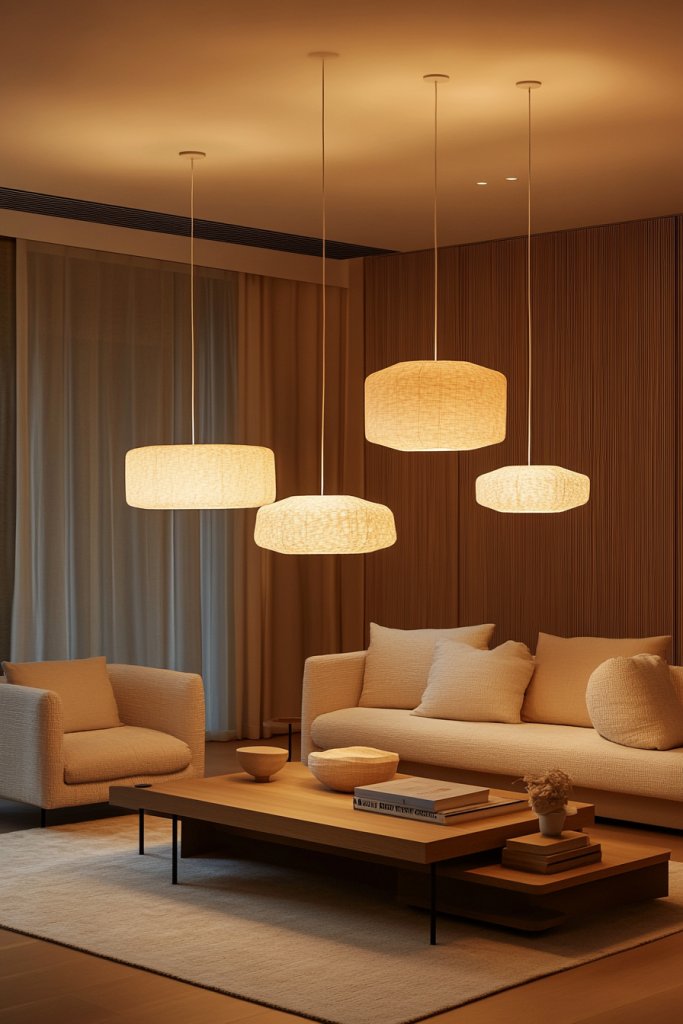
Lighting plays a crucial role in creating a warm, inviting Japandi living room, and choosing fixtures made of paper or fabric enhances the soft, diffuse glow that embodies serenity. These fixtures—such as paper lanterns, fabric pendant lights, or simple sconces—add a gentle ambiance without overwhelming the space with harsh brightness.
Their subtle glow casts a warm, calming light that complements the room’s neutral palette. Picture a delicate paper lantern hanging from the ceiling, softly illuminating the room with a warm, amber hue.
Alternatively, a fabric-covered sconce with a minimalist design offers an understated touch, providing ambient light that feels cozy and intimate. These fixtures often feature natural materials like rice paper, linen, or cotton, which diffuse light beautifully and add a tactile element.
The overall effect is a gentle, welcoming atmosphere perfect for relaxation or quiet conversation. To incorporate this lighting, start with a central paper pendant light in a neutral tone—think off-white or soft beige—that hangs at a comfortable height.
Add wall sconces or table lamps with fabric shades made of linen or cotton for layered lighting. Many affordable options are available online or at home stores, often with easy-to-install fixtures. Aim for warm, dimmable bulbs to adjust the mood, creating a soothing environment that invites calmness and mindfulness.
6. Use Monochrome or Limited Color Accents for Sophistication
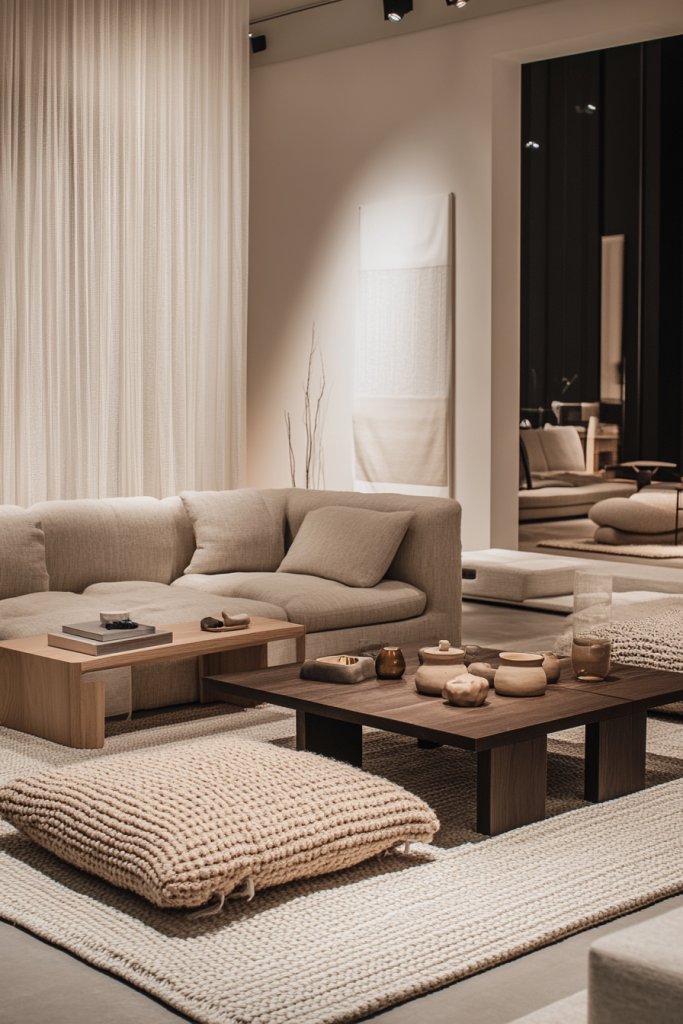
In a Japandi living room, restraint is key—using monochrome palettes or subtle color accents elevates the minimalist aesthetic while adding depth and sophistication. This approach emphasizes the beauty of simplicity, allowing textures and materials to stand out, and creates a cohesive, calming environment.
Small touches like black or charcoal accessories, deep earth-toned cushions, or a dark-toned throw can provide visual interest without overwhelming the space. Imagine a neutral backdrop of soft beige walls and light wood furniture, accented with a few carefully chosen elements in deep charcoal or black.
These could be a sleek ceramic vase, a set of sculptural candleholders, or a textured cushion in a deep, muted hue. The contrast draws the eye and adds a layer of richness to the room, while still maintaining the overall serene vibe.
Using a limited color palette also helps keep the space feeling uncluttered and harmonious, aligning with the Japandi principle of subtlety and balance. To implement this idea, select a primary neutral color for your walls and larger furniture pieces.
Then, introduce one or two accent shades—such as black, dark brown, or deep grey—in small decor items, textiles, or ceramics. Keep the accents minimal and purposeful, focusing on quality and texture. This restrained color strategy ensures your living room remains elegant, modern, and effortlessly sophisticated, perfect for creating a peaceful sanctuary.
7. Add Soft, Layered Lighting with Candles or Lamps
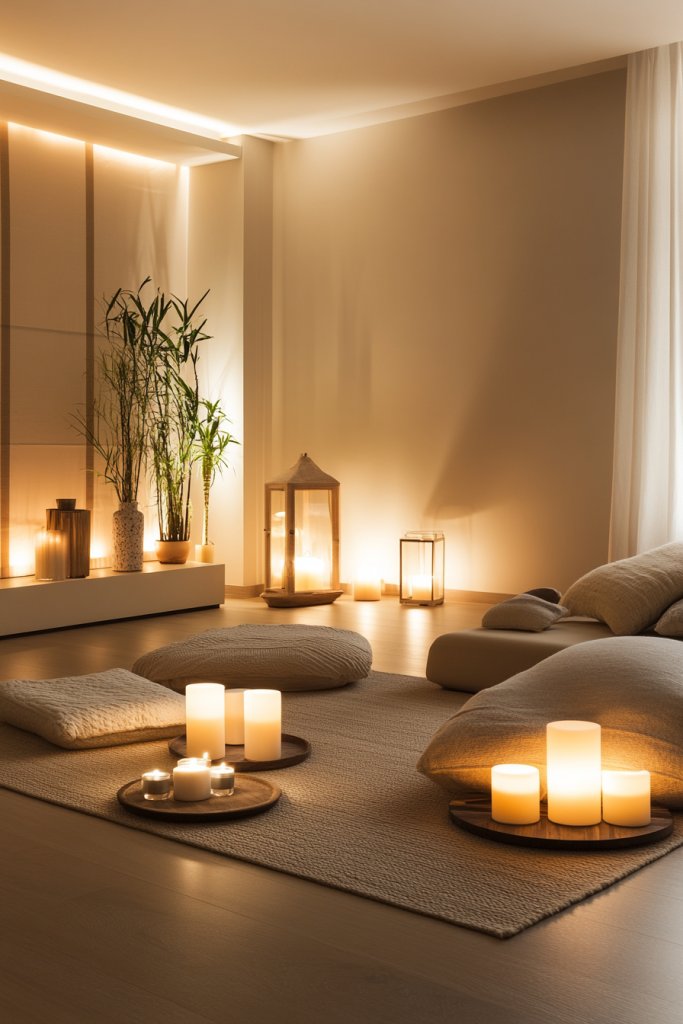
Creating a warm, inviting glow is essential to achieving the tranquil ambiance that defines Japandi style. Soft, layered lighting—comprising candles, dimmable lamps, and diffused fixtures—enhances the room’s serenity by casting gentle light and subtle shadows.
This approach not only sets a calming mood but also highlights textures and materials, making the space feel cozy and thoughtfully curated. Picture a living room illuminated by a combination of warm-toned pendant lights with fabric shades, a few flickering candles on coffee tables, and perhaps a minimalist table lamp with a soft fabric cover.
The lighting is carefully balanced, providing enough brightness for daytime activities while remaining gentle enough for evening relaxation. The flickering of candle flames adds a tactile, sensory dimension, making the space feel intimate and peaceful.
The overall effect is a layered, harmonious lighting scheme that encourages unwinding and mindfulness. To achieve this, start with a main light source—such as a dimmable ceiling light or pendant—and add smaller, softer light sources like candles or table lamps in warm bulbs (around 2700K).
Use shades made of paper, fabric, or ceramic to diffuse light evenly. Incorporate dimmer switches to adjust brightness easily and create different moods throughout the day. This layered lighting setup transforms your living room into a cozy retreat that welcomes calmness and reflection.
8. Integrate Traditional Japanese Textiles and Fabrics
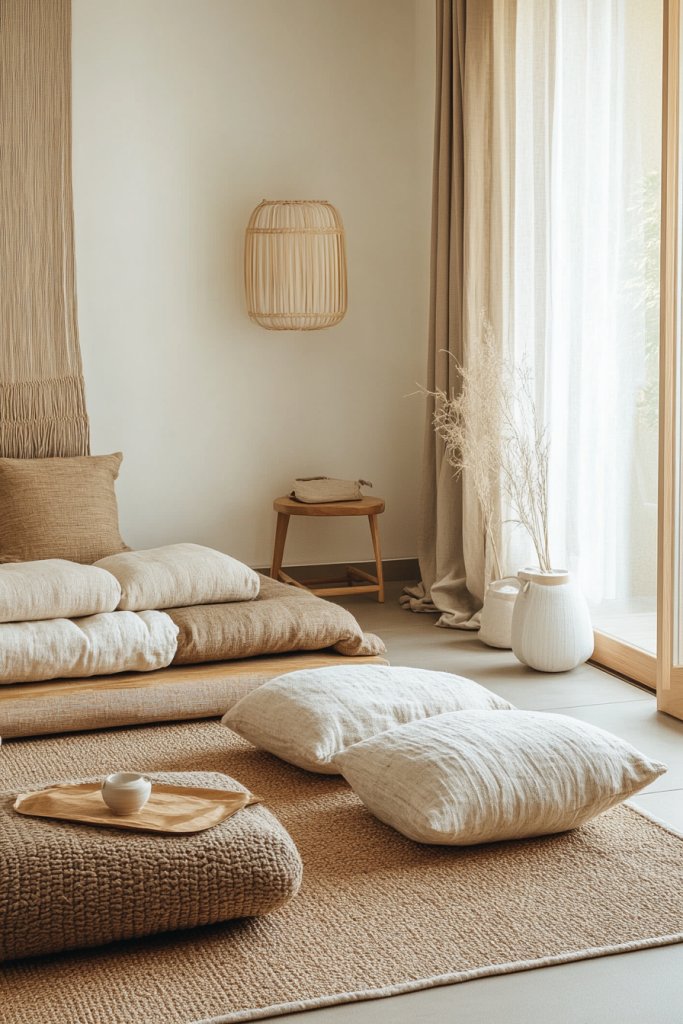
Incorporating authentic Japanese textiles and fabrics adds both tactile warmth and cultural depth to a Japandi living room. Elements like woven futon cushions, linen throws, or soft fabric-covered poufs evoke traditional craftsmanship and enhance the room’s cozy, inviting atmosphere.
These textiles bring tactile interest and a sense of authenticity, seamlessly blending functionality and aesthetic appeal. Visualize a plush, neutral-toned linen cushion placed on a sleek low sofa, or a woven mat with intricate patterns layered on the floor for extra texture.
Soft throws in natural fibers—like a chunky knit or a smooth linen—are casually draped over furniture, inviting touch and comfort. Incorporating fabrics with subtle patterns or textures, such as subtle stripes or woven weaves, complements the clean lines of Japandi decor while adding warmth.
These textiles create a layered, harmonious space that feels both serene and culturally inspired. To incorporate these textiles, look for items like woven futon cushions, linen cushions, or soft poufs in muted, natural colors.
You can find authentic Japanese fabrics at specialty stores or online, or choose modern, minimalist versions that echo traditional textures. Layering these fabrics on your seating or flooring enhances comfort and adds subtle visual interest, transforming your living room into a serene, inviting haven rooted in Japanese design principles.
9. Incorporate Sculptural and Artistic Decorative Objects
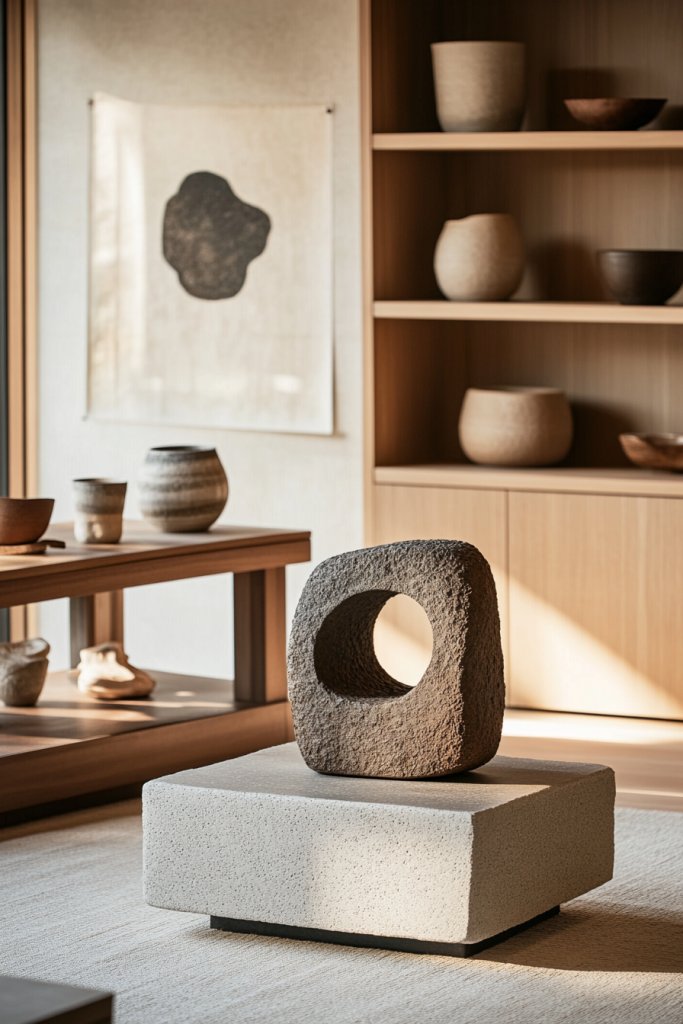
Adding sculptural and artistic objects introduces focal points and a sense of craftsmanship that elevates the overall aesthetic of a Japandi living room. These pieces—whether modern sculptures, handcrafted ceramics, or minimalist ornaments—serve as conversation starters and emphasize the importance of form and materiality in Japandi design.
Carefully chosen decorative objects balance simplicity with artistic expression, enriching the space. Imagine a sleek, minimalist sculpture made of matte black stone positioned on a console table, or handcrafted ceramic vases with organic shapes placed on open shelving.
Sculptural objects in natural materials like wood, clay, or stone bring tactile richness, while their clean lines and subtle details reinforce the room’s sense of harmony. These focal points draw the eye without overwhelming the space, embodying the Japanese appreciation for craftsmanship and understated beauty.
To incorporate such objects, select a few key pieces with simple yet striking forms—think geometric shapes or naturalistic sculptures—and place them thoughtfully on surfaces like side tables, shelves, or mantels. Focus on quality and material rather than quantity, ensuring each object contributes to the overall calm, balanced aesthetic. These artistic accents provide a sophisticated finishing touch that celebrates both functionality and artistry, completing your serene Japandi living room.
10. Use Minimalist Window Treatments for Natural Light Control
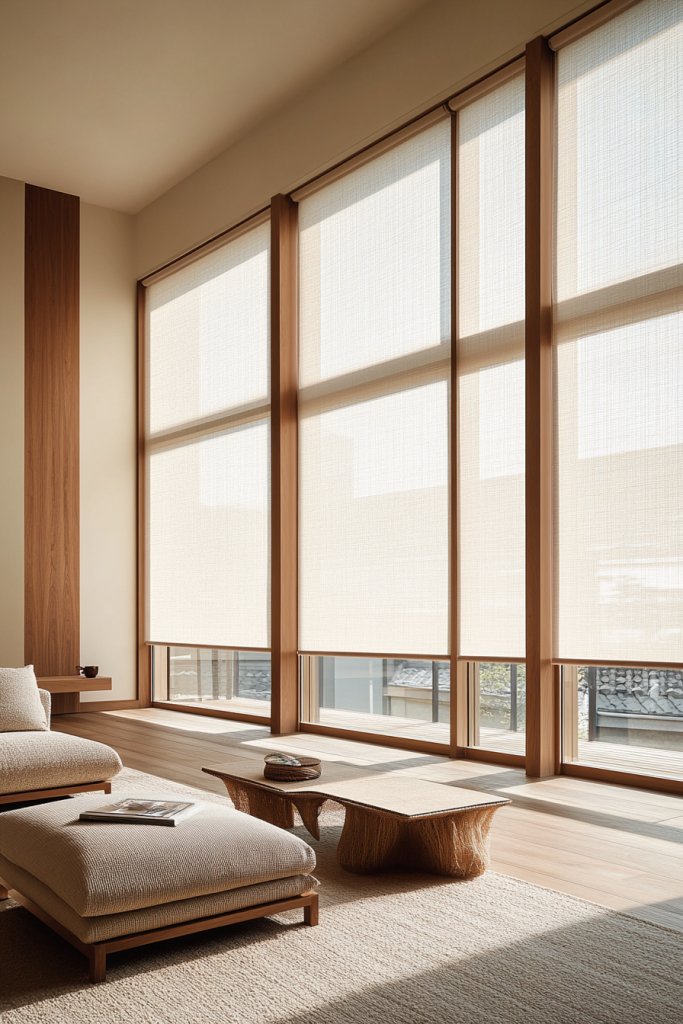
Harnessing natural light is essential to achieving the airy, tranquil feel of a Japandi living room, and minimalist window treatments are the perfect solution. They allow you to filter sunlight gently into the space while maintaining a clean, uncluttered look that complements the overall aesthetic.
Imagine sheer, lightweight curtains in neutral tones like soft beige or pale grey that drift softly when a breeze passes through, creating a calming movement. Alternatively, simple roller blinds or sleek wooden slats can be easily adjusted to control brightness without adding visual noise.
These treatments should be unobtrusive, often in natural materials like linen, cotton, or bamboo, which blend seamlessly with the room’s organic vibe. The goal is to balance daylight and privacy while enhancing the room’s serene atmosphere, making the space feel open yet cozy.
To implement this, start by measuring your windows to select appropriately sized coverings. For a quick and budget-friendly option, install simple roller or Roman blinds in natural fabrics, or hang sheer curtains with minimal hardware—preferably in matte finishes to avoid distraction.
For a more permanent solution, consider wooden or bamboo shades that can be easily lifted or lowered to suit the time of day. These treatments are straightforward to install and require little maintenance, making them accessible even for beginners aiming to craft a calming, light-filled Japandi living room.
11. Curate a Cohesive and Inviting Atmosphere
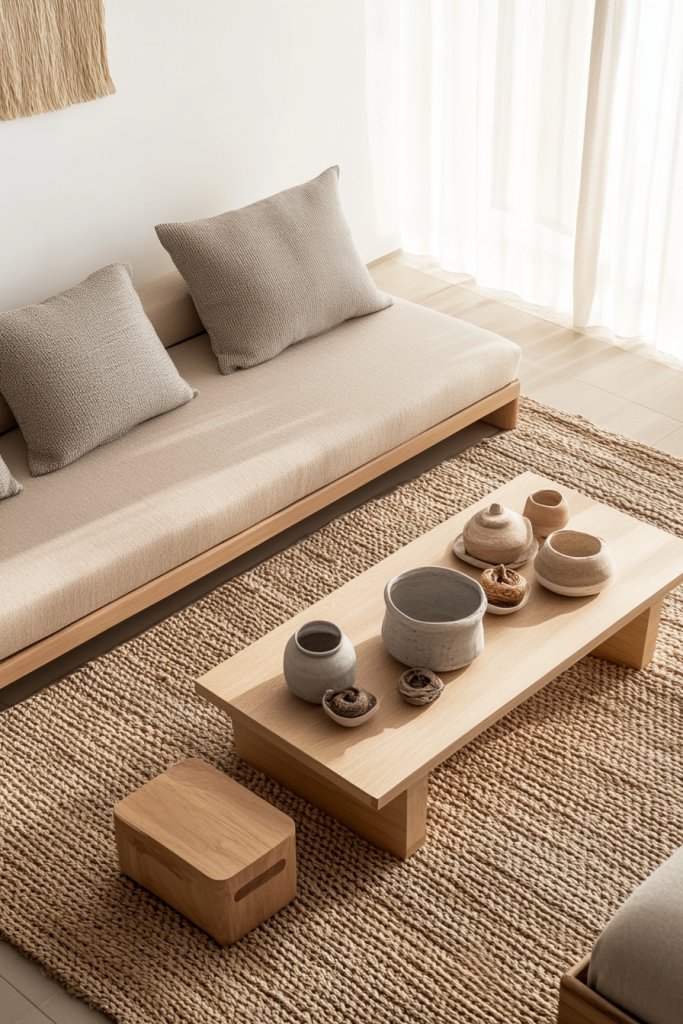
Creating a harmonious and welcoming Japandi living room is about thoughtful curation—blending textures, shapes, and subtle accents to foster a peaceful environment. It’s not just about furniture, but about how each element contributes to a balanced, soothing space that feels both functional and inviting.
Visualize a room where soft, neutral-colored textiles—like a plush, cream-colored linen sofa paired with a cozy, chunky-knit throw blanket—are complemented by handcrafted ceramic bowls or sculptural wooden decor pieces. The furniture is low-profile and sleek, arranged symmetrically to promote calm and order.
Warm lighting, from a paper lantern or dimmable sconce, bathes the room in a gentle glow, enhancing the tactile textures of woven cushions, linen curtains, and smooth ceramics. The overall vibe is understated elegance, with each element thoughtfully placed to promote relaxation and harmony.
To achieve this, start by choosing a cohesive color palette of muted earth tones and soft neutrals. Select furniture with clean lines—think low, streamlined sofas and minimalist coffee tables—and add textured textiles for warmth.
Incorporate decorative objects like handcrafted ceramics or subtle sculptures that serve as focal points without overwhelming the space. Finish with warm lighting and a clutter-free layout, ensuring every piece has a purpose. This thoughtful approach makes your living room not only stylish but also a peaceful sanctuary that welcomes relaxation at any time.
Conclusion
Transforming your living room with these Japandi ideas offers a perfect blend of serenity, style, and functionality. From neutral palettes and minimalist furniture to natural textures and thoughtful lighting, each element contributes to a harmonious space that promotes calm and well-being.
Don’t hesitate to experiment with these concepts to create a tranquil retreat that reflects your personal taste. Embrace the simplicity and elegance of Japandi style—your serene sanctuary awaits.
Leave a Reply